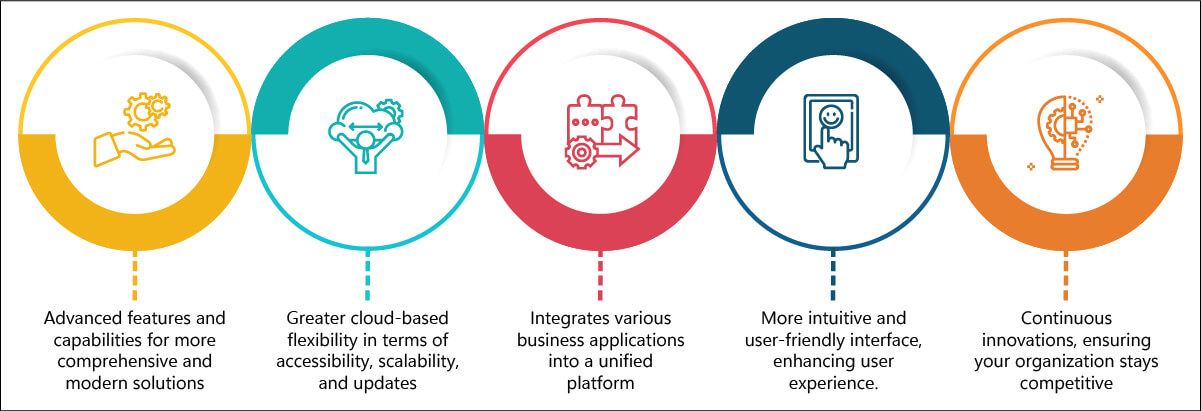The term ‘upgrade’ is commonly used for any movement from Dynamics AX to 365. But the reality is upgrade and migration are two distinct paths.
When you step into the upgrade odyssey, the entire database undergoes a transformation. It seamlessly transits to the new system. So, if you are currently on Dynamics AX 2012 R2 or R3 with minimum to zero customizations, this upgrade route will be a win-win. And why not? After all, Microsoft offers a robust toolset to facilitate this conversion of your entire database to Dynamics 365 F&O.
But why an upgrade when it is working fine for you?
Imagine your business as a high-performance sports car. While it’s been serving you well, technology is advancing, and competitors are upgrading to sleeker, more efficient models. Why? To navigate efficiently through various challenges with agility and speed.
Likewise, to stay ahead of the competition, you must explore new features, functionalities, and possibilities that can redefine the way you operate and compete.
Moreover, the upgrade becomes a necessary step because:
- Microsoft ceased updates and support for Dynamics AX, leaving users without the crucial support services they require for seamless operations.
- The on-premises nature of Dynamics AX presents an impediment to managing global operations.
- The shift to Dynamics 365 Finance and Operations isn’t just about technological advancement; it’s a strategic move that can substantially reduce IT infrastructure costs by 15%. The migration to cloud deployment is a key contributor to this efficiency.
- The move to Dynamics 365 Finance and Operations holds the promise of a 23% reduction in errors and a noteworthy 30% decrease in inventory costs.
These tangible benefits underscore the impact of the upgrade on operational efficiency.
According to a Forrester report, embracing Dynamics 365 Finance and Operations can yield a remarkable 112% Return on Investment (ROI) over a three-year period. This includes cost savings and efficiency improvements, positioning the transition as a strategic investment.
Are these reasons enough to validate to jump into the upgrade odyssey immediately?
So, when does migration prove a win-win?
Dynamics AX 2009 or AX 2012 (pre-R2) users encounter a unique challenge as the existing Microsoft toolset lacks the compatibility required for these older versions. Migration emerges as the preferred method, offering a tailored solution that aligns with the intricacies of these legacy systems.
Opting for migration becomes imperative when the need arises to overhaul extensive customizations. If you find yourself in a position where a substantial reduction or replacement of customizations is necessary, coupled with major configuration changes, migration provides the flexibility and adaptability required for this transformative process.
But to have a successful migration process, it is important to have insights into the data migration framework. This will help you to understand-
- Roadmap for precision
- The intricacies of carrying out the migration process accurately and minimizing the risk of data errors.
- Preserving data integrity.
- Meeting compliance and regulatory requirements
- Better utilization of migrated data.
5 reasons why migrating from Dynamics AX to Dynamics 365 is essential:

Data migration framework insights:
Focused data conversion:
Microsoft’s data migration framework ensures a focused conversion, primarily targeting master data and open transactions. This precision allows for a seamless transition of crucial, up-to-date information.
Handling historical data:
It’s crucial to recognize that historical data, while not converted through the migration process, retains its significance. Microsoft Dynamics AX accommodates this by preserving historical data within the system. Alternatively, for those seeking a comprehensive data repository, Azure database tools offer a pathway to move historical data into a dedicated data warehouse.
In essence, insights into the data migration framework are not just a luxury; they are a necessity for a successful and efficient migration process. They empower businesses to navigate the complexities of data transition with confidence, ensuring that the journey to a new system is not only seamless but also optimized for future success.
Upgrade Vs. Migration Criteria
Upgrade
|
Migration
|
| Note- Microsoft’s evolving licensing terminology now designates Dynamics 365 Finance and Supply Chain Management as the official name, even though many still refer to it as Dynamics 365 Finance & Operations (D365FO). This shift underscores the continuous evolution and refinement of the Dynamics suite to meet the ever-changing needs of businesses. | |
Your transition, your choice
Whether you’re eyeing the efficiency boost of an upgrade or the strategic advantages of a migration, the journey from Dynamics AX to Dynamics 365 is an opportunity to future-proof your ERP experience. Dive into the digital transformation era with confidence, knowing that your chosen path aligns with your unique business requirements.
As the Dynamics landscape evolves, so do the solutions offered by Microsoft. To ensure a smooth transition, consider consulting with Dynamics 365 experts who can guide you through the intricacies of your chosen path. Embrace the future of ERP solutions with Dynamics 365 Finance and Supply Chain Management, where your business’s potential knows no bounds.
